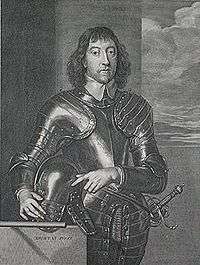Henry Howard, 22nd Earl of Arundel
| The Earl of Arundel | |
|---|---|
 | |
| Spouse(s) | Lady Elizabeth Stuart |
|
Issue
Thomas Howard, 5th Duke of Norfolk Henry Howard, 6th Duke of Norfolk Lord Philip Howard Lord Charles Howard Lord Bernard Howard | |
| Noble family | House of Howard |
| Father | Thomas Howard, 21st Earl of Arundel |
| Mother | Alethea Talbot |
| Born | 15 August 1608 |
| Died | 17 April 1652 |
Henry Frederick Howard, 22nd Earl of Arundel PC (15 August 1608 – 17 April 1652) was an English nobleman, chiefly remembered for his role in the development of the rule against perpetuities.
Background
Arundel was the second son of Thomas Howard, 21st Earl of Arundel and Lady Alethea Talbot, later 13th Baroness Furnivall. After his father's death in 1646 he became Earl of Arundel and the titular head of the Howard family.
Early life
Arundel's grandmother Anne, the dowager Countess, arranged for Henry to be baptized and christened as "Frederick Henry" at Woodstock Palace with Anne of Denmark as godmother. Prince Henry and Princess Elizabeth were also present.[1] He studied at St John's College, Cambridge, matriculating in 1624.[2]
Public life
Before ascending to the peerage, Lord Arundel had served as Member of Parliament for Arundel in the Parliament of England from 1628 until 1629, and again in 1640. He also represented Callan in the Parliament of Ireland in 1634. He had been due to inherit his mothers peerage (Baron Furnivall), but he pre-deceased her and upon her death in 1654 it was inherited by his eldest son Thomas.
The entailment
Henry sought to control the succession to some of his real property after his death. Toward that end, he placed in his will a shifting executory limitation so that title to some property would pass to his eldest son (who was mentally deficient) and then to his second son, and title to other property would pass to his second son, and then to his fourth son. The estate plan also included provisions for shifting the titles many generations later if certain conditions should occur.
When his second son, Henry, succeeded to the elder brother's property, he did not want to pass the other property to his younger brother, Charles. Charles sued to enforce his interest, and the court (in this instance, the House of Lords) held that such a shifting condition could not exist indefinitely. The judges believed that tying up property too long beyond the lives of people living at the time was wrong, although the exact period was not determined for another 150 years. [3]
Family
Lord Arundel married Lady Elizabeth Stuart, daughter of Esme Stuart, 3rd Duke of Lennox, on 7 March 1626. They had nine sons and three daughters:
- Thomas Howard, 5th Duke of Norfolk (1626/27–1677), died without issue
- Henry Howard, 6th Duke of Norfolk (1628–1683/84), had issue; (ancestor of 7th through 9th Dukes of Norfolk)
- Hon. Philip Howard (1629–1694), Catholic Cardinal
- Hon. Charles Howard (1630–1713), married Mary Tattershall (d. 1695), had issue, including Henry Howard of Greystoke; who married Mary Aylward (d. 1747), had issue, including Charles Howard, 10th Duke of Norfolk (through whom Charles Howard, 11th Duke of Norfolk was also descended);
- Lady Anne Howard (1632–?)
- Lady Catherine Howard (1634–1655)
- Hon. Talbot Howard (1636–?)
- Hon. Edward Howard (1637–1691), married Anne Wilbraham, had issue. Edward's great-grandson Thomas Howard (1736–1824), a Quaker, renounced succession c.1812; succession then passed to the issue of Hon. Bernard Howard of Glossop (below).
- Hon. Francis Howard (1640–1683) Died in Geele, Belgium as stated in his brother Cardinal Philip Howard's Biography.
- Hon. Bernard Howard of Glossop (1641–1717), married Catherine Tattershall (d. 1727, sister of his brother Charles' wife, Mary) and had issue, including Bernard Howard II of Glossop, who married Anne Roper (d. 1744), had issue, including Henry Howard of Glossop and Sheffield, who married Juliana Molyneux, had issue, including Bernard Howard, 12th Duke of Norfolk (from who all subsequent Dukes of Norfolk descend) and Lord Henry Howard-Molyneux-Howard;
- Hon. Esme Howard (1645–1728), had one daughter, who died unmarried
- Lady Elizabeth Howard (1651–1705)
- Hon. John Howard (1652–1711)
Ancestry
| Ancestors of Henry Howard, 22nd Earl of Arundel | ||||||||||||||||||||||||||||||||||||||||||||||||||||||||||||||||||||||||||||||||||||||||||||||||||||||||||||||||||||||||||||||||||||||||||||||||||||||||||||||||||||||||||||||||||||||||||||||||||||||||||||||||||||||||||||||||||||||||||||||||||||||||||||||||||||||||||||||||||||||||||||||||||||||||||||||||||||||||||||||||||||||||||||||||||||||||||||||||||||||||||||||||||||||||||||||||||||||||||||||||||||||||||||||||||||||||||||||||||||||||||||||||||||||||||||||||||||||||||||||||||||||||||||||||||||||||||||||||||
|---|---|---|---|---|---|---|---|---|---|---|---|---|---|---|---|---|---|---|---|---|---|---|---|---|---|---|---|---|---|---|---|---|---|---|---|---|---|---|---|---|---|---|---|---|---|---|---|---|---|---|---|---|---|---|---|---|---|---|---|---|---|---|---|---|---|---|---|---|---|---|---|---|---|---|---|---|---|---|---|---|---|---|---|---|---|---|---|---|---|---|---|---|---|---|---|---|---|---|---|---|---|---|---|---|---|---|---|---|---|---|---|---|---|---|---|---|---|---|---|---|---|---|---|---|---|---|---|---|---|---|---|---|---|---|---|---|---|---|---|---|---|---|---|---|---|---|---|---|---|---|---|---|---|---|---|---|---|---|---|---|---|---|---|---|---|---|---|---|---|---|---|---|---|---|---|---|---|---|---|---|---|---|---|---|---|---|---|---|---|---|---|---|---|---|---|---|---|---|---|---|---|---|---|---|---|---|---|---|---|---|---|---|---|---|---|---|---|---|---|---|---|---|---|---|---|---|---|---|---|---|---|---|---|---|---|---|---|---|---|---|---|---|---|---|---|---|---|---|---|---|---|---|---|---|---|---|---|---|---|---|---|---|---|---|---|---|---|---|---|---|---|---|---|---|---|---|---|---|---|---|---|---|---|---|---|---|---|---|---|---|---|---|---|---|---|---|---|---|---|---|---|---|---|---|---|---|---|---|---|---|---|---|---|---|---|---|---|---|---|---|---|---|---|---|---|---|---|---|---|---|---|---|---|---|---|---|---|---|---|---|---|---|---|---|---|---|---|---|---|---|---|---|---|---|---|---|---|---|---|---|---|---|---|---|---|---|---|---|---|---|---|---|---|---|---|---|---|---|---|---|---|---|---|---|---|---|---|---|---|---|---|---|---|---|---|---|---|---|---|---|---|---|---|---|---|---|---|---|---|---|---|---|---|---|---|---|---|---|---|---|---|---|---|---|---|---|---|---|---|---|---|---|---|---|---|---|---|---|---|---|---|---|---|---|---|---|---|---|---|---|---|---|---|---|---|---|---|---|---|---|---|---|---|---|---|---|---|---|---|---|---|---|---|---|---|---|---|---|---|---|---|---|---|---|---|---|---|---|---|---|---|---|---|---|---|---|---|---|---|---|---|---|---|---|---|---|---|---|---|---|---|---|---|---|
| ||||||||||||||||||||||||||||||||||||||||||||||||||||||||||||||||||||||||||||||||||||||||||||||||||||||||||||||||||||||||||||||||||||||||||||||||||||||||||||||||||||||||||||||||||||||||||||||||||||||||||||||||||||||||||||||||||||||||||||||||||||||||||||||||||||||||||||||||||||||||||||||||||||||||||||||||||||||||||||||||||||||||||||||||||||||||||||||||||||||||||||||||||||||||||||||||||||||||||||||||||||||||||||||||||||||||||||||||||||||||||||||||||||||||||||||||||||||||||||||||||||||||||||||||||||||||||||||||||
References
- thePeerage.com
- Tudor Palace
-
 "Howard, Henry Frederick". Dictionary of National Biography. London: Smith, Elder & Co. 1885–1900.
"Howard, Henry Frederick". Dictionary of National Biography. London: Smith, Elder & Co. 1885–1900.